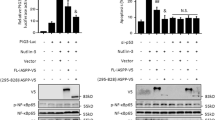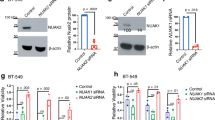Abstract
Fibroblast growth factor-2 (FGF-2) is known for its mitogenic and motogenic effects on breast cancer cells. Here, we demonstrate that FGF-2 is also a potent stimulator of breast cancer cell survival, as it counteracts the apoptotic activity of the C2 ceramide analogue and various chemotherapeutic agents (5-fluorouracil, camptothecin, etoposide) in MCF-7, T47-D and BT-20 cells. The use of pharmacological inhibitors (PD98059, wortmannin, LY294002, SN50) and transfection with negative dominants (IκBm, p110(PI3K (phosphoinositide 3-kinase))*ΔK, AktND) or small interfering RNA targeted against Akt indicated that PI3K/Akt and nuclear factor-κB (NF-κB), but not p42/p44 MAP-kinases, were required to stimulate FGF-2 antiapoptotic activity. The activation of NF-κB was dependent on PI3K/Akt, and using a combination of approaches based on immunoprecipitation, Western blotting and proteomics (two-dimensional electrophoresis and mass spectrometry), we identified the beta form of IκB kinase (IKKβ) as a target of Akt signaling. The selective disruption of IKKβ using small interfering RNA induced a potent inhibition of Akt-mediated activation of NF-κB and cell survival, indicating the functional involvement of IKKβ in FGF-2 antiapoptotic signaling. Together, these results demonstrate Akt/IKKβ interaction in NF-κB pathways, thereby emphasizing the potential of these proteins as therapeutic targets in breast cancer.
This is a preview of subscription content, access via your institution
Access options
Subscribe to this journal
Receive 50 print issues and online access
$259.00 per year
only $5.18 per issue
Buy this article
- Purchase on Springer Link
- Instant access to full article PDF
Prices may be subject to local taxes which are calculated during checkout





Similar content being viewed by others
References
Ajenjo N, Aaronson DS, Ceballos E, Richard C, Leon J and Crespo P . (2000). J. Biol. Chem., 275, 7189–7197.
Alessi DR, Caudwell FB, Andjelkovic M, Hemmings BA and Cohen P . (1996). FEBS Lett., 399, 333–338.
Ballif BA and Blenis J . (2001). Cell Growth Differ., 12, 397–408.
Bange J, Zwick E and Ullrich A . (2001). Nat. Med., 7, 548–552.
Berwick DC, Hers I, Heesom KJ, Moule SK and Tavare JM . (2002). J. Biol. Chem., 277, 33895–33900.
Bhakar AL, Roux PP, Lachance C, Kryl D, Zeindler C and Barker PA . (1999). J. Biol. Chem., 274, 21443–21449.
Carlson CJ, White MF and Rondinone CM . (2004). Biochem. Biophys. Res. Commun., 316, 533–539.
Creedon DJ, Johnson EM and Lawrence JC . (1996). J. Biol. Chem., 271, 20713–20718.
Descamps S, Toillon RA, Adriaenssens E, Pawlowski V, Cool SM, Nurcombe V, Le Bourhis X, Boilly B, Peyrat JP and Hondermarck H . (2001). J. Biol. Chem., 276, 17864–17870.
Dickson C, Spencer-Dene B, Dillon C and Fantl V . (2000). Breast Cancer Res., 2, 191–196.
Du K and Montminy M . (1998). J. Biol. Chem., 273, 32377–32379.
Fenig E, Wieder R, Paglin S, Wang H, Persaud R, Haimovitz-Friedman A, Fuks Z and Yahalom J . (1997). Clin. Cancer Res., 3, 135–142.
Fingar DC and Blenis J . (2004). Oncogene, 23, 3151–3171.
Gibbs JB . (2000). J. Clin. Invest., 105, 9–13.
Greene MW, Sakaue H, Wang L, Alessi DR and Roth RA . (2003). J. Biol. Chem., 278, 8199–8211.
Hondermarck H . (2003). Mol. Cell Proteomics, 2, 281–291.
Karin M, Yamamoto Y and Wang QM . (2004). Nat. Rev. Drug Discov., 3, 17–26.
Kulik G, Klippel A and Weber MJ . (1997). Mol. Cell. Biol., 17, 1595–1606.
Kurebayashi J, McLeskey SW, Johnson MD, Lippman ME, Dickson RB and Kern FG . (1993). Cancer Res., 53, 2178–2187.
Lawlor MA and Alessi DR . (2001). J. Cell Sci., 114, 2903–2910.
Li J, DeFea K and Roth RA . (1999). J. Biol. Chem., 274, 9351–9356.
Luo J, Manning BD and Cantley LC . (2003). Cancer Cell, 4, 257–262.
Manetti F and Botta M . (2003). Curr. Pharm. Des., 9, 567–581.
McLeskey SW, Kurebayashi J, Honig SF, Zwiebel J, Lippman ME, Dickson RB and Kern FG . (1993). Cancer Res., 53, 2168–2177.
Mora A, Komander D, van Aalten DM and Alessi DR . (2004). Semin. Cell Dev. Biol., 15, 161–170.
Murphy PR, Limoges M, Dodd F, Boudreau RT and Too CK . (2001). Endocrinology, 142, 81–88.
Nurcombe V, Smart CE, Chipperfield H, Cool SM, Boilly B and Hondermarck H . (2000). J. Biol. Chem., 275, 30009–30018.
Obata T, Yaffe MB, Leparc GG, Piro ET, Maegawa H, Kashiwagi A, Kikkawa R and Cantley LC . (2000). J. Biol. Chem., 275, 36108–36115.
Ornitz DM and Itoh N . (2001). Genome Biol., 2, 1–12 (reviews 3005).
Ozes ON, Akca H, Mayo LD, Gustin JA, Maehama T, Dixon JE and Donner DB . (2001). Proc. Natl. Acad. Sci. USA, 98, 4640–4645.
Ozes ON, Mayo LD, Gustin JA, Pfeffer SR, Pfeffer LM and Donner DB . (1999). Nature, 401, 82–85.
Pardo OE, Arcaro A, Salerno G, Raguz S, Downward J and Seckl MJ . (2002). J. Biol. Chem., 277, 12040–12046.
Polnaszek N, Kwabi-Addo B, Peterson LE, Ozen M, Greenberg NM, Ortega S, Basilico C and Ittmann M . (2003). Cancer Res., 63, 5754–5760.
Rahmoune H, Chen HL, Gallagher JT, Rudland PS and Fernig DG . (1998). J. Biol. Chem., 273, 7303–7310.
Romashkova JA and Makarov SS . (1999). Nature, 401, 86–90.
Suyama K, Shapiro I, Guttman M and Hazan RB . (2002). Cancer Cell, 2, 301–314.
Takei Y, Kurobe M, Uchida A and Hayashi K . (1994). Clin. Chem., 40, 1980–1981.
Vercoutter-Edouart A, Lemoine J, Smart CE, Nurcombe V, Boilly B, Peyrat J and Hondermarck H . (2000). FEBS Lett., 478, 209–215.
Vercoutter-Edouart AS, Lemoine J, Le Bourhis X, Louis H, Boilly B, Nurcombe V, Revillion F, Peyrat JP and Hondermarck H . (2001). Cancer Res., 61, 76–80.
Villafuerte BC, Phillips LS, Rane MJ and Zhao W . (2004). J. Biol. Chem., 279, 36650–36659.
Zhang L, Kharbanda S, McLeskey SW and Kern FG . (1999). Cancer Res., 59, 5023–5029.
Acknowledgements
We thank J Antol for his excellent technical assistance. This work was supported by grants from the French Ministry for Research and Education, the ‘Institut Universitaire de France’ and the ‘Ligue Nationale Contre le Cancer (Comité du Nord et de la Somme)’ and the ‘Association pour la Recherche sur le Cancer’.
Author information
Authors and Affiliations
Corresponding author
Rights and permissions
About this article
Cite this article
Vandermoere, F., El Yazidi-Belkoura, I., Adriaenssens, E. et al. The antiapoptotic effect of fibroblast growth factor-2 is mediated through nuclear factor-κB activation induced via interaction between Akt and IκB kinase-β in breast cancer cells. Oncogene 24, 5482–5491 (2005). https://doi.org/10.1038/sj.onc.1208713
Received:
Revised:
Accepted:
Published:
Issue Date:
DOI: https://doi.org/10.1038/sj.onc.1208713
Keywords
This article is cited by
-
Pre-activated nanoparticles with persistent luminescence for deep tumor photodynamic therapy in gallbladder cancer
Nature Communications (2023)
-
Chronic pathophysiological changes in the normal brain parenchyma caused by radiotherapy accelerate glioma progression
Scientific Reports (2021)
-
The antipsychotic agent trifluoperazine hydrochloride suppresses triple-negative breast cancer tumor growth and brain metastasis by inducing G0/G1 arrest and apoptosis
Cell Death & Disease (2018)
-
Smilax china L. rhizome extract inhibits nuclear factor-κB and induces apoptosis in ovarian cancer cells
Chinese Journal of Integrative Medicine (2015)
-
Activation of Akt1 accelerates carcinogen-induced tumorigenesis in mammary gland of virgin and post-lactating transgenic mice
BMC Cancer (2014)



